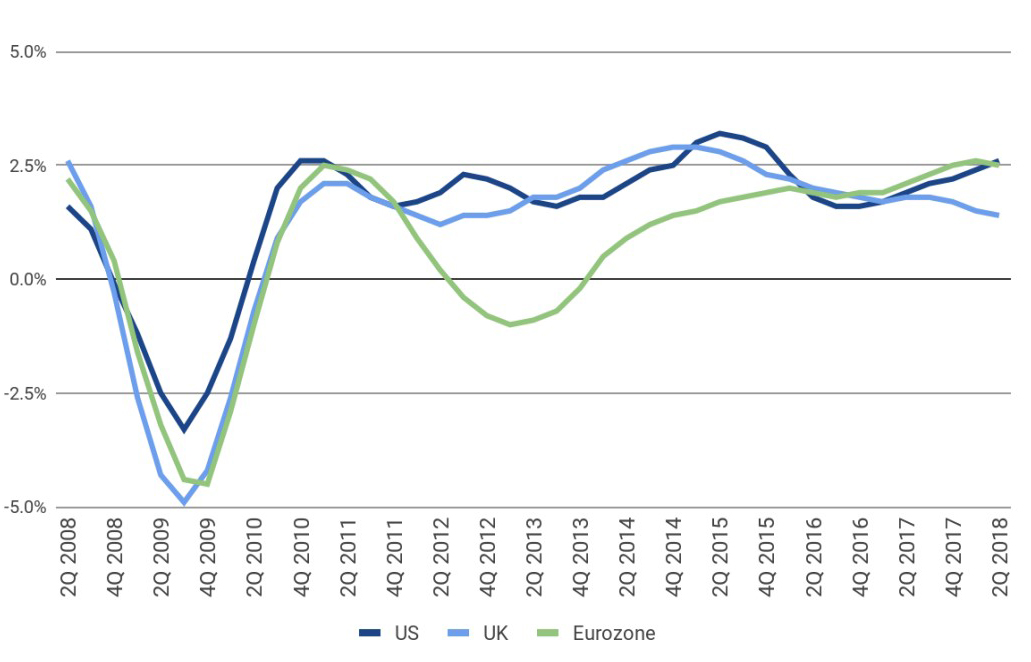
Global Real Estate Outlook
Subscribe to our Insights Leave your email address to be the first to hear about insights.
Economic and Political Highlights
The global economic expansion continues at a steady pace, while potential risks increase. The shift toward protectionist policies by the US and potential for no-deal Brexit have made trade policy a key risk to growth. Divergent central bank policies pose a risk as the US Federal Reserve Bank (Fed) raises interest rates and the European Central Bank (ECB) remains accommodative. Relatively loose central bank policy combined with high debt-to-gross domestic product (GDP) ratios across most countries may also limit policy solutions available to curb the next recession.
Exhibit 1: Annualized Real Gross Domestic Product Growth

Source: US Bureau of Economic Analysis, Organization for Economic Co-operation and Development (OECD), and Eurostat; retrieved from FRED, Federal Reserve Bank of St. Louis, October 2018.
US economic momentum is solidly positive, but vulnerable to tariffs, immigration restrictions, and healthcare costs. The expansion has been modest with average annual growth of just 2.2% from mid-2009 through mid-2018, per the US Bureau of Economic Analysis. The labor market has rebounded with the unemployment rate at a 49-year low of 3.7% in September 2018 and monthly job growth still trending above 200,000 in 2018, per the US Bureau of Labor Statistics (BLS). Despite continued increases in employment, wage growth has lagged in the current expansion, never breaking out above 3.0% growth on an annual basis since 2009 (BLS). Inflation is edging higher with the annual trend slightly above the Fed’s 2% target over the past year (BLS). These conditions have led the Fed to tighten monetary policy, bringing the federal funds rate from near zero to a range of 2.0% to 2.25% after their September 2018 meeting. As a result, mortgage rates and bond yields are rising, equity market benchmarks have retreated from historic highs, and the yield curve has flattened. Economic growth in the Eurozone is stable with inflation in check, edging just below 2% in August 2018 with core inflation at just 1.0%, per Oxford Economics. Steady growth in the UK brought unemployment to a 43-year low of 4.0% at mid-year, per the OECD. There are, however, considerable challenges to near-term growth. Risk is rising for a no-deal Brexit, which leaves only a reversion to World Trade Organization rules as a back-up plan. The proposed Italian budget, which anticipates a deficit in 2019, may force a confrontation with the European Commission and has already widened the spread between Italian and German bond yields. The ECB is still utilizing negative rate policy and has no plan in place to manage another debt crisis, leaving the region vulnerable to the next downturn. However, the absence of rising interest rates in the region as the Fed tightens in the US could support Eurozone growth and capital flows into the region.
Implications for Real Estate Investment
Relatively low interest rates and the flattening yield curve have supported real estate returns as well as generated capital flows into the asset class. Core and non-core non-listed real estate fund performance can be observed in the Global Real Estate Funds Index report. The reported total return is net of fees and based upon fund level data provided directly from investment managers. Non-core fund returns in both the US and UK/Europe are outperforming core funds as expected for late-cycle real estate performance. Over the past year, US core fund performance has been lagging not only non-core fund performance in the US, but also UK/Europe fund performance for both core and non-core strategies. Despite moderating performance, non-listed real estate fund returns tend to compare favorably to listed real estate with trailing year total returns through the second quarter of 2018 of 4.93%, 9.34%, and 12.14% for the US Equity REIT, NAREIT UK, and NAREIT Eurozone Indices, respectively.
Exhibit 2: Annualized Real Estate Fund Total Returns by Strategy
Source: 2Q 2018 Global Real Estate Fund Index (GREFI) by National Council of Real Estate Investment Fiduciaries (NCREIF), European Association for Investors in Non-Listed Real Estate Vehicles (INREV), and Asian Association for Investors in Non-Listed Real Estate Vehicles (ANREV), data as of September 26, 2018. Per DWS, the average global real estate yield spread to government bond yields was 2.9% at the end of 2017, above the long-term average of 2.2%. Late cycle fundamentals with low vacancy and elevated rents are behind this attractive yield premium. However, differences across regions and property type are important considerations. The most challenged global property type is retail due to the shift toward omnichannel sourcing, which reduces tenant demand for physical retail space. This challenge to retail does translate into opportunities for logistics space demand. Office pricing remains elevated, especially for core markets and assets where investor appetite is strong.
Summary
The outlook for the global economy is cautiously optimistic, leaving expectations for real estate investment relatively sanguine. Risks to growth bear watching with moderating growth in the short-term serving as a reasonable baseline for expectations. The real estate yield premium to to government bonds also implies that the asset class can whether the rise in interest rates, which is already underway in the US. Avoiding real estate completely is never an appropriate strategy for a balanced portfolio, but it is important to observe headwinds by region and property type to determine how best to allocate capital.
Exhibit 3: Short-Term Forecasts for Key Indicators
Source: Oxford Economics, as of September 19, 2018. *Eurozone bond yield reported as German 10-year yield. Written by Arif Rahim, Acting Head – Asset Management Division and Head of Investment Strategy







